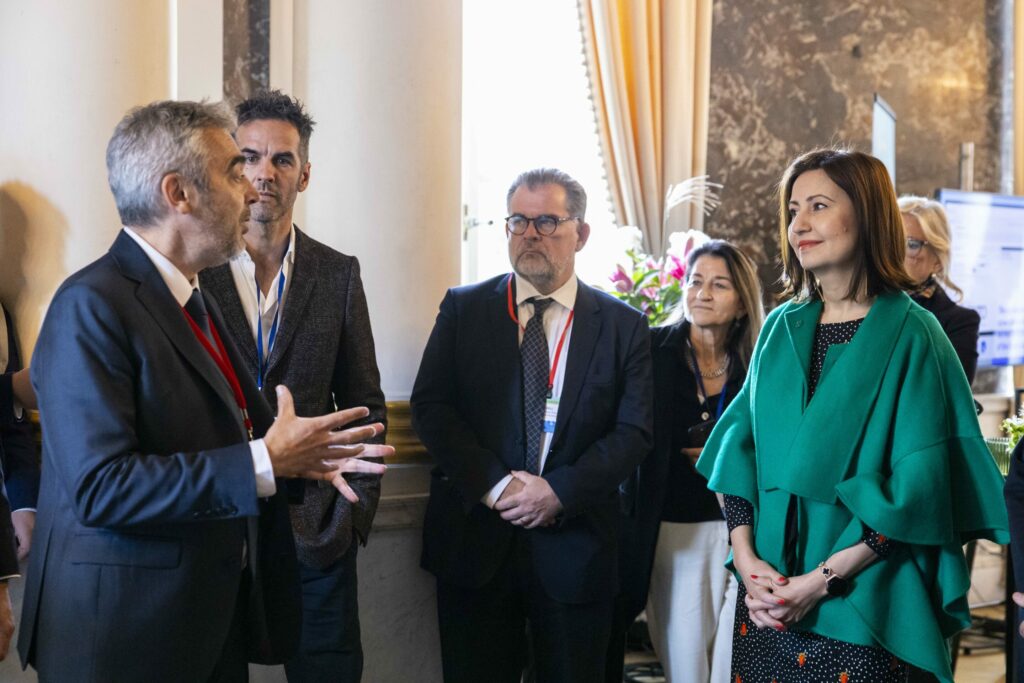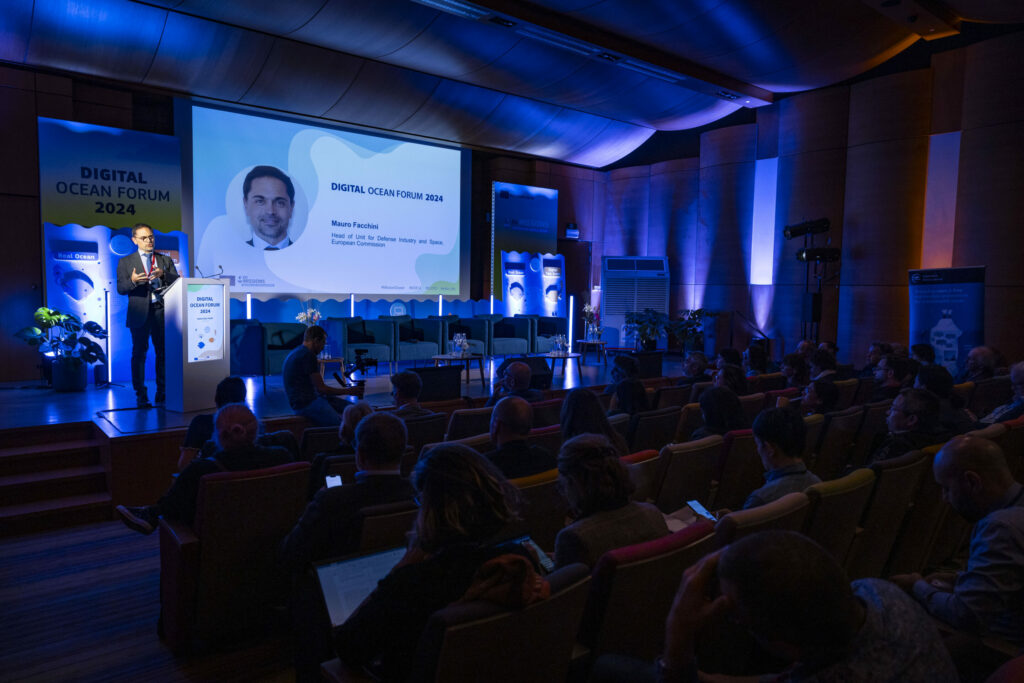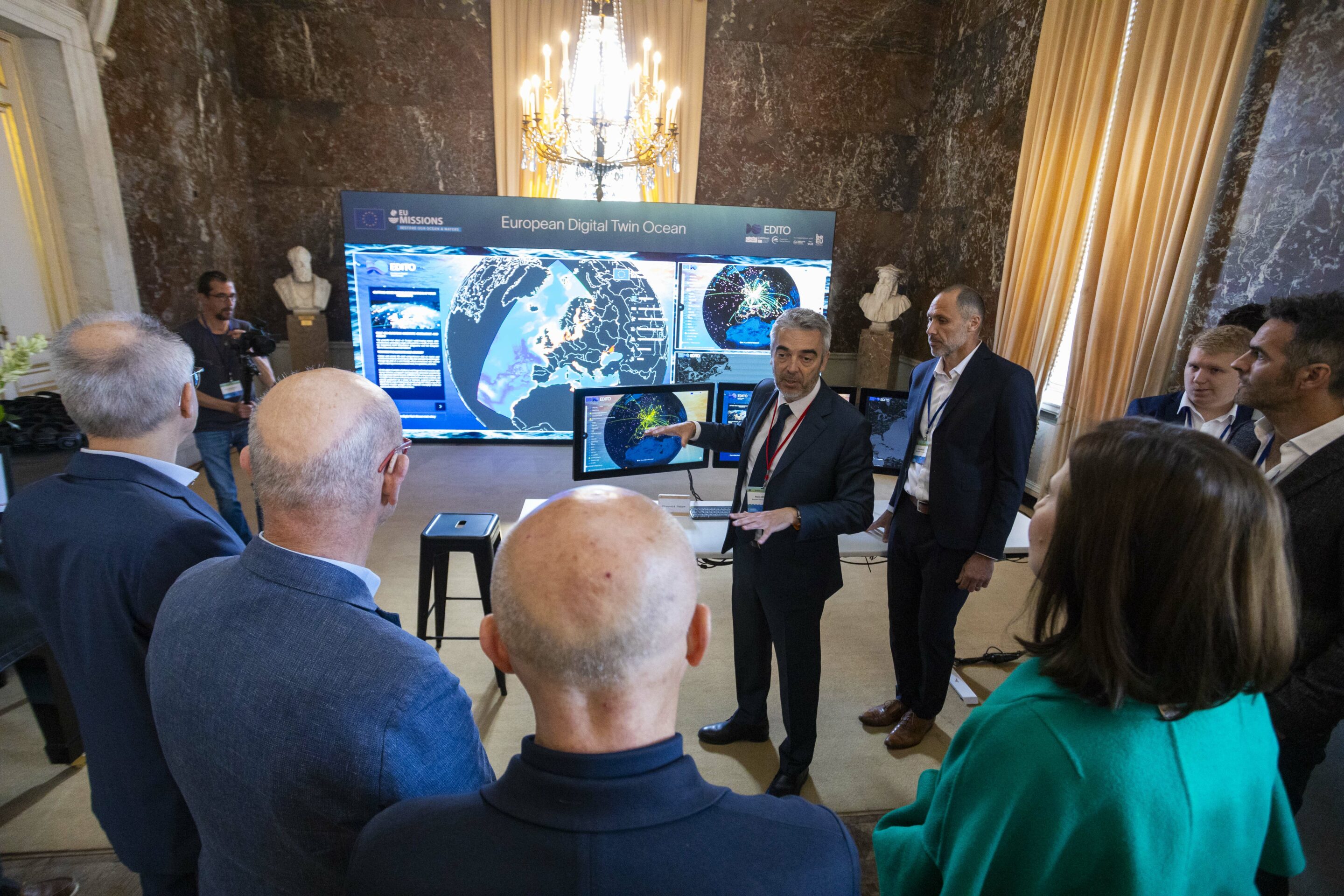This event, a key calendar event of the EU’s "Restore our Ocean and Waters" mission, brought together an array of climate/environmental and policy stakeholders, including senior representatives from five European Commission Directorates-General (DGs).
The forum, organised by the Directorate-General for Research and Innovation (DG RTD), the Directorate-General for Maritime Affairs and Fisheries (DG MARE), and the Directorate-General for Defence Industry and Space (DG DEFIS), with support from Mercator Ocean International and the Flanders Marine Institute (VLIZ), notably unveiled the new European Digital Twin Ocean (EU DTO), a ground-breaking initiative aimed at transforming marine data accessibility, combining new and existing resources to help policymakers plan for the seas of tomorrow.
Digital Twin Ocean
High Level Intervention with Iliana Ivanova, European Commissioner for Innovation, Research, Culture, Education and Youth.
In a private live demonstration of the EU DTO platform, Iliana Ivanova, European Commissioner for Innovation, Research, Culture, Education and Youth and key stakeholders were shown data on marine plastic waste tracking, revealing significant plastic waste at sea originating from European countries.
The visualisation left a significant impact on the European official who noted that countries had "work to do” in tackling pollution. “The Digital Twin Ocean is really extraordinary and unprecedented,” she told journalists during the demonstration. She also commented that by harnessing this new platform, national authorities could now be held responsible for their polluting actions.
“It will help us understand how pollution and human activities affect the ocean and its critical role in regulating the climate and preserving biodiversity. It is still a prototype, but once it’s fully up and running, the platform will become a game-changer in ocean management,” she said.
Mercator Ocean International Director (MOi) General Pierre Bahurel led demos of the brand-new EU DTO pre-operational platform before a crowd of assembled dignitaries, stakeholders and future EU DTO users.
“The platform represents a groundbreaking initiative, providing an advanced digital model of the ocean that integrates real-time data and simulations. This tool is crucial for enhancing our understanding of marine environments and supporting sustainable ocean management,” the Mercator director told the high-profile guests.
The event also attracted several key figures from the EU institutions, including European Commissioner Florika Fink-Hooijer (DG ENV) and Gustav Kalbe, Head of Unit for Administration & Finance, in the Communications Networks, Content and Technology (DG CNECT).
This platform, set to enter full operation in 2025, combines data and services from the flagship European Copernicus Marine Service (implemented by MOi) and EMODnet, and other providers into a single, comprehensive digital framework. By integrating artificial intelligence (AI) and high-performance computing, the EU DTO aims to revolutionise oceanographic models, providing new tools for ocean adaptation and mitigation, sustainable ocean resource management and blue economic development.
This new platform unlocks a myriad of new possibilities for policymakers, enabling users from across the globe to run important “what-if” scenarios. Using the EU DTO, users can help map and visualise the impact of decisions on biodiversity, coastal protection, protected sea areas, and as well as the impacts inaction.
Powerful new toolbox
The forum underscored the EU's commitment to environmental protection and innovation, aligning with the EU Green Deal, Digital Strategy, and the UN Decade of Ocean Science for Sustainable Development. Attendees, including key stakeholders like John Bell, Director of Healthy Planet at DG for Research and Innovation (DG RTD), and Kestutis Sadauskas, Deputy Director-General for Maritime Affairs and Fisheries (DG MARE), witnessed demonstrations of the EU DTO’s capabilities in marine litter management, biodiversity conservation, renewable energy, early warning systems, and coastal monitoring.
Bell highlighted the transformative potential of the Digital Twin Ocean: "Our understanding of the ocean is crucial for our future as a society and economy,” he told participants at the conference. “The Digital Twin Ocean will revolutionise our interaction with the ocean, providing a comprehensive way to understand and predict its dynamics.”
Demo of a plastics tracking application in the EU DTO that can be used to combat marine plastic pollution.
From planning coastal activities to managing ecosystems, the EU official said the new tool offers would be vital in decision-making for preparing for “extreme weather events” and “aquaculture opportunities.”
The importance of the EU DTO becomes even more apparent when considering the challenges facing the world's oceans today. According to the European Environment Agency, marine ecosystems are under significant stress from pollution, overfishing, and climate change. The EU DTO could be harnessed to address several marine challenges facing Europe, including Baltic Sea eutrophication or overfishing in the Mediterranean Sea.

Alain Arnaud (Head of Digital Ocean, Mercator Ocean International) explaining how the EU DTO enables sophisticated “what-if” scenarios to stakeholders including Commissioner Ivanova and John Bell, Director of Healthy Planet RTD. © Bernal Revert/BR&U.
Marine litter, particularly plastic waste, has become a global crisis. Scientists report that in 2021, 75 to 200 million tonnes of plastics are estimated to be in the ocean, with Europe contributing a significant share. Plastic pollution not only affects marine life but also enters the food chain, posing health risks to humans. The EU DTO provides a platform for policymakers to assess how to best protect the oceans from human activity.
The EU DTO is a truly collaborative effort, involving stakeholders from both the private and public sector. Over 70 EU-funded projects were represented in a preceding scientific and technical workshop on the EU DTO, which aimed to gather feedback and establish priorities for future developments.
The digital twin, DG MARE Deputy Director-General Sadauskas explained, is a leading example of stakeholder engagement and the ability to collaborate on broad climate goals.
"The goal was to build a foundation and an interface necessary to bring together all that we know about the ocean,” he explained during his speech. “This foundation will allow the marine community to build on this knowledge and create tailor-made applications that capture the details of our coastal and marine ecosystems."
"For me, the true value of embarking on the development of the EU digital twin ocean is really the creation of this community that works together towards the common goal of describing and understanding the ocean, its biodiversity, and most importantly, its interactions with us, with our societies, our economies, our way of life," he said.
Leveraging new technologies
The digital copy of the ocean brings together a variety of existing sources and aggregates them into one convenient and interactive platform. One important player in the EU DTO platform is the European Marine Observation and Data Network (EMODnet), a leading EU-run in-situ marine data service with data from a variety of European institutions, and the Copernicus Marine Service, providing satellite, in-situ, and numerical models to view the ocean in past, present (near real-time) and future (forecasts) from the surface to depth across the blue (physical), white (sea ice) and green (biogeochemical and biological) ocean.
Kestutis Sadauskas, Deputy Director-General for Maritime Affairs and Fisheries (DG MARE) unveiling the European Digital Twin Ocean prototype.
Sadauskas praised EMODnet's role: "Without EMODnet, the Digital Twin Ocean wouldn't be possible. It plays a crucial role by ensuring that diverse marine data is harmonised and accessible." This combination of different platforms will be helpful in supporting the EU’s broader mission of integrating high-performance computing and AI in ocean research through the EU’s seven-year Horizon Europe research initiative.
Other data sources, such as the EU’s flagship Earth observation programme, Copernicus, brings powerful data, infrastructure and services to the new EU DTO platform through its Copernicus Marine Service. In a keynote speech at the Digital Ocean Forum, Mauro Facchini, Head of Unit for Defence Industry and Space (DG DEFIS), highlighted the power of the technologies behind these services. The Copernicus programme, for which Facchini’s DG is responsible, relies on a vast array of satellites and supercomputers, which are now integrated into the marine platform.
“High-performance computing has a key role in the digital twin,” he explained. “We hope that by providing cross-cutting data across the world, we can bring additional capacities and reduce the time needed for reporting."

Mauro Facchini, Head of Unit for Defence Industry and Space (DG DEFIS). © Bernal Revert/BRU.
Combining these powerful data and service sources, ordinary users of the platform will soon be able to run powerful simulations leveraging numerous data sources. For instance, its predictive modelling tools can help urban planners design resilient coastal cities, taking into account future sea-level rise and extreme weather patterns. Environmental agencies can also harness its data to monitor and protect marine biodiversity, while the fishing industry can use its insights to ensure sustainable practices.
“The European Digital Twin Ocean aims to unify fragmented marine data, making it readily accessible and usable for everyone from specialists to ordinary citizens," Sadauskas explained. "By consolidating marine science and knowledge into a single platform, the Digital Twin Ocean ensures that data is up to date, fit for purpose, and understandable for all users."
‘Turning the lights on in the ocean’
The DOF2024 event was marked by insightful speeches and remarks from several key figures behind the initiative. On the sidelines of the event, DG RTD’s John Bell told The Brussels Times about the technological potential of the new platform.
"The Digital Twin Ocean offers the decision-making capabilities necessary for preparing for extreme weather events, addressing invasive algal blooms, and even optimising aquaculture opportunities," he said. “The vision is to make the ocean a familiar and manageable space for citizens, ensuring that our economic and environmental decisions are backed by the latest science and technology."
With a public demo of the platform already available to select testers, European authorities expect the full EU DTO public infrastructure platform to gradually scale up throughout 2025. In the coming months, there will be opportunities for further beta testing by industry stakeholders.
"The significance of what has been started today is not to be understood in the confines of this room,” echoed Bell. “With the launch of this EU DTO, we’re turning the lights on in the ocean, and the future of how our civilization can understand its dilemma and work with our ecosystems."
The Brussels Times

